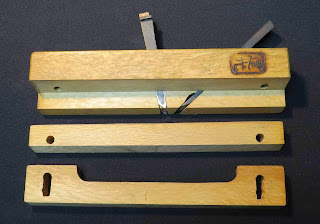Ari shakuri kanna (dovetail plane) - dai rebuild
Ari shakuri (jyakuri) kanna - dai rebuild:
Knowing that I had many sliding dovetails to make, I looked on eBay for a solid, undamaged, and relatively unused kanna that would suffice as a plane for sliding dovetails. I found this:

There is a lot of important information in a dai, even a warped or damaged one. Examining every single cut and surface is important if you want to duplicate it. I will say it looked like whoever made this one hand cut to their lines and probably knocked it out very rapidly. It took me 2 days to recondition the blades and make the new dai. I pulled all of the geometry from the original and transferred it to my slightly larger copy, rendered in 50 year old maple (not ideal, but what i had).
Usually you start by tuning up the blades and make the dai to fit. In this case I did that with the knicker blade, but then moved on to the dai because I did not want to guess at (or calculate) the main blade geometry.
Once all of the cuts are finished, you can cut the bottom angle (77 degrees in this case). I made some angled blocks to hold the dai while planing to final shape.
I got the dai to where I wanted it, then marked up the main blade tip with a Magic Marker, then tapped it in until it protruded from the dai bottom, then scribed all around it to define grind lines, and finally sharpened it. Here are the blades in approximate position:
I was not sure if the shaving would follow the desired path, but:
The shaving shows signs of chatter so it is likely that there is no support behind the tip of the blade and the blade is vibrating. Probably the original did not do this, but I can shim it and live with it for now. The most critical intersection of the nicker blade and the main blade is accurate and the resulting angle and 77 degree corner is precise. Also added was a fence to limit the size of the tail. It is fixed to the dai with some tapped holes and machine screws.
There is no depth stop on this plane, so you need to control that carefully. Here is the finished kanna:
And here is the final product:
-------------------------------------------------------------------------------------
But wait, time has passed and I found the real thing:
The included angle on this plane is more like 20 degrees.
You will also notice that there are 3 main (wooden) parts, two of which are removable:
The whole thing is held together with two machine screws that fit in holes drilled at an angle such that they pop out the top of the dai (where there are 2 captive nuts). By adding and removing the fence and parallelogram shaped spacer block, you can cut both the male and female parts of a sliding dovetail.
Here is the blade set, 2 nickers and the main blade. The wood wedge is actually the spacer block to set the distance between the nicker blades.
This old example also arrived with a warped dai so there is a bit of work to be done before this plane will see service.
















Comments
-David
It also shows an Ai-jyakuri-ganna - which is really what I started with. Figure 4 shows the differences. I am not sure there is a standard or range of angles sold. Many tools are modified to suit the owner or the task. Thanks for your interest.